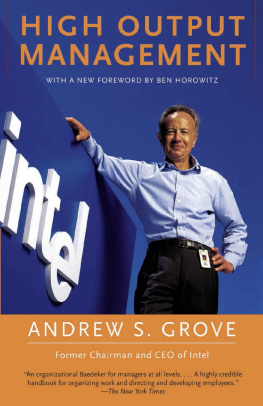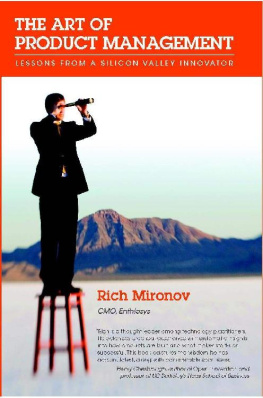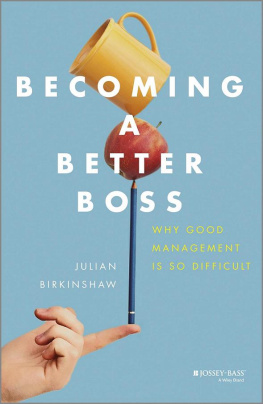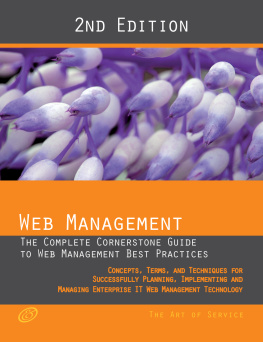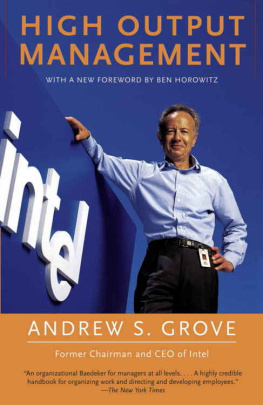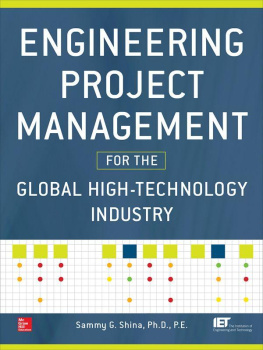The ideas in this book are the result of a collective effortmy collaboration with many, many Intel managers over the years. I am very grateful to all of them, because I learned everything I know about how to manage from them. I am especially grateful to Gordon Moore, one of the founders of Intel, who recognized the budding manager under my engineers skin long before I had any inkling myself.
Thanks are also due to a group of the companys middle managers who cheerfully accepted the role of guinea pig, who suffered through my first attempts to articulate these ideas, and who also generously provided me with experiences from their daily lives as managers. Ive used their examples to illustrate certain points in the book. These managers are acknowledged by name in the Notes.
I owe special thanks to Grant Ujifusa, my Random House editor, who tirelessly hammered away at the rough edges of my ideas and prose and translated the latter into Englishfrom the original engineeringese; to Pam Johnson, who ran the various revisions through the word processor; and most of all to Charlene King, my assistant, who not only helped to pull the whole project together, from capturing class discussions to gathering illustrations, but also made sure that I did my work of running Intel even as I was busily splitting infinitives.
Introduction
I. What happened after 1983
I wrote this book in 1983. It was the result of twenty years of managerial work during which I learned a variety of ways to make things take place more effectively. What I learned were the basics of managerial work, particularly as they pertained to middle managers. More than a decade has passed since, but I find that most of the things that were useful then are still useful now; the basics of management remain largely unaffected.
However, two critical events took place in the 1980s that altered the environment in which we managers do our workand this made me realize that an updated Introduction to this book was necessary. Those events were the Japanese memory onslaught and e-mail.
Let me explain their implications.
By the mid-eighties, the Japanese producers of Dynamic Random Access Memories, or DRAMs for shortthe most popular computer memory devices, used in computers of all kindshad perfected their technological capability and honed their manufacturing prowess to the extent that they could take on the American producers (who had pioneered the market and totally dominated it for the first fifteen years of its existence). The mid-eighties were also when the personal computer revolution took place. And because personal computers require a lot of memory, the Japanese DRAM juggernaut had a ready market for its products centered in the United States. Everything was primed for an attack.
Intel, where I work, was one of the companies that got caught up in this assault. In fact, Intel was one of the early producers of DRAMs. More than that, in its earliest years, we had practically the whole market to ourselves. However, by the mid-eighties, competition both from the United States and, increasingly, from Japanese manufacturers whittled down our share of the market. Under the ferocious attack of aggressively priced, high-quality Japanese DRAMs, we were forced to retreat and cut prices to a level where being in the DRAM business brought us major losses. Ultimately, the losses forced us to do something extraordinarily difficult: to back out of the business that the company was founded upon, and to focus on another business that we thought we were best atthe microprocessor business.
While this adjustment sounds quite logical and straightforward in theory, in reality its implementation required us to move and redeploy a lot of our employees, let some of them go, and shutter a number of factories. We did all this because under this strong attack, we learned that we must lead with our strength. Being second best in a tough environment is just not good enough.
Ultimately, weIntel and the U.S. semiconductor industryprevailed over the onslaught of the Japanese manufacturers. Intel grew to become the largest semiconductor manufacturer in the world, and U.S. manufacturers recently surpassed their Japanese counterparts overall. Nevertheless, in retrospect its clear that this assault was just one wave of a much larger tidethe tide of globalization.
Globalization simply means that business knows no national boundaries. Capital and workyour work and your counterparts workcan go anywhere on earth and do a job.
Some of us are fortunate to be residents of a country, the United States, that enjoys one of the highest standards of living. The U.S. market for goods and services is the largest in the world. And until recently, it has been easier to supply that market from inside the United States than from abroad.
Today, many markets outside the United States are growing faster than markets inside the U.S. And the domestic market can be supplied from anywhere in the world. For example, I recently bought a Gore-tex jacket from Patagonia (the clothing manufacturer, not the region in South America), and I saw that it was made in China: American brand, American technology (the high-tech fabric was invented and made in the United States), and assembled to the specifications of the reseller (Patagonia) in a foreign country.
The consequence of all this is very simple. If the world operates as one big market, every employee will compete with every person anywhere in the world who is capable of doing the same job. There are a lot of them, and many of them are very hungry.
Another consequence also follows. When products and services become largely indistinguishable from each other, all there is by the way of competitive advantage is time. And thats where the second critical development of the eighties comes ine-mail.

